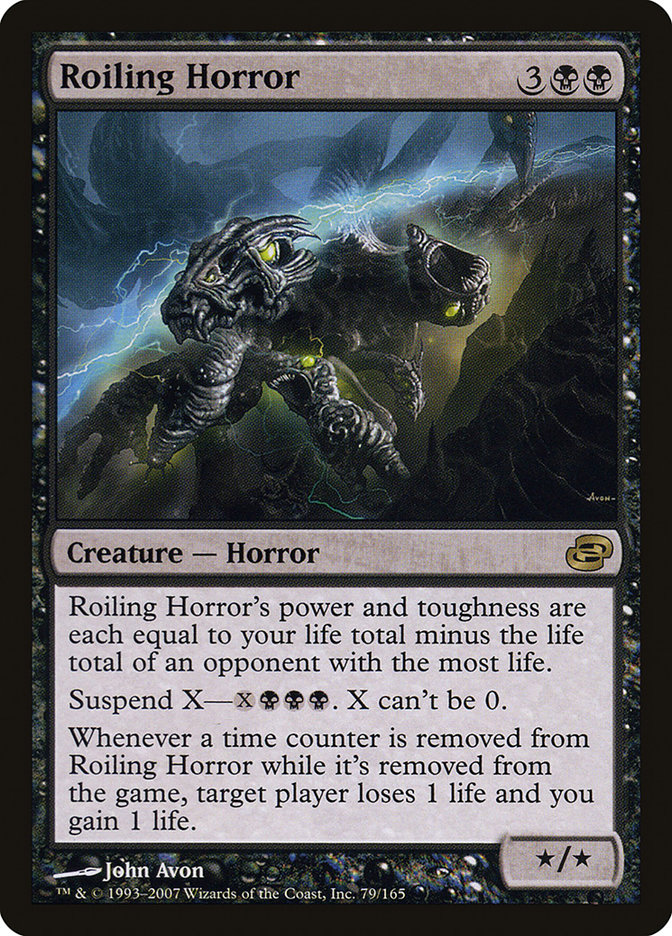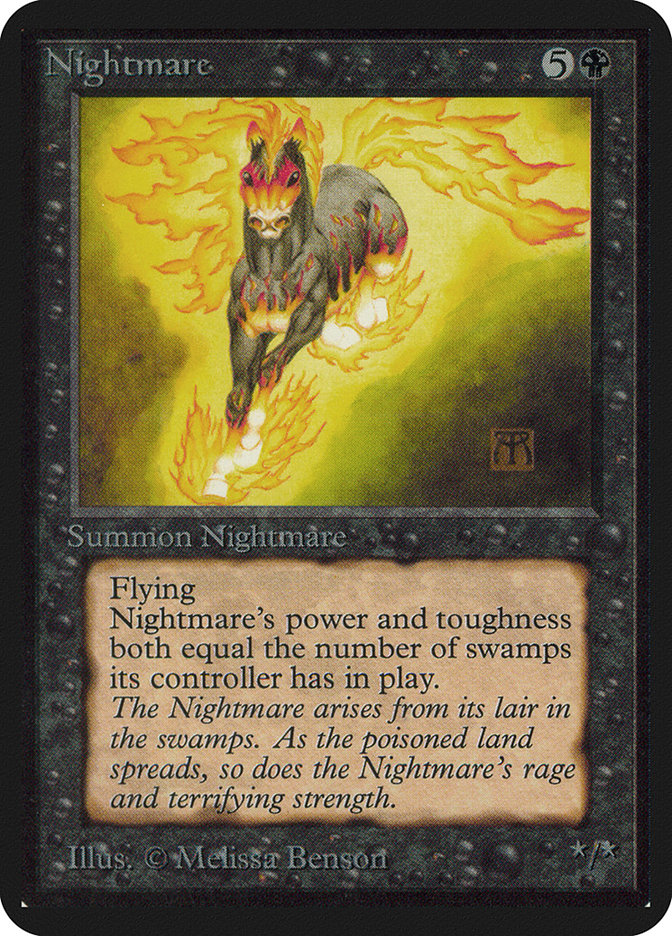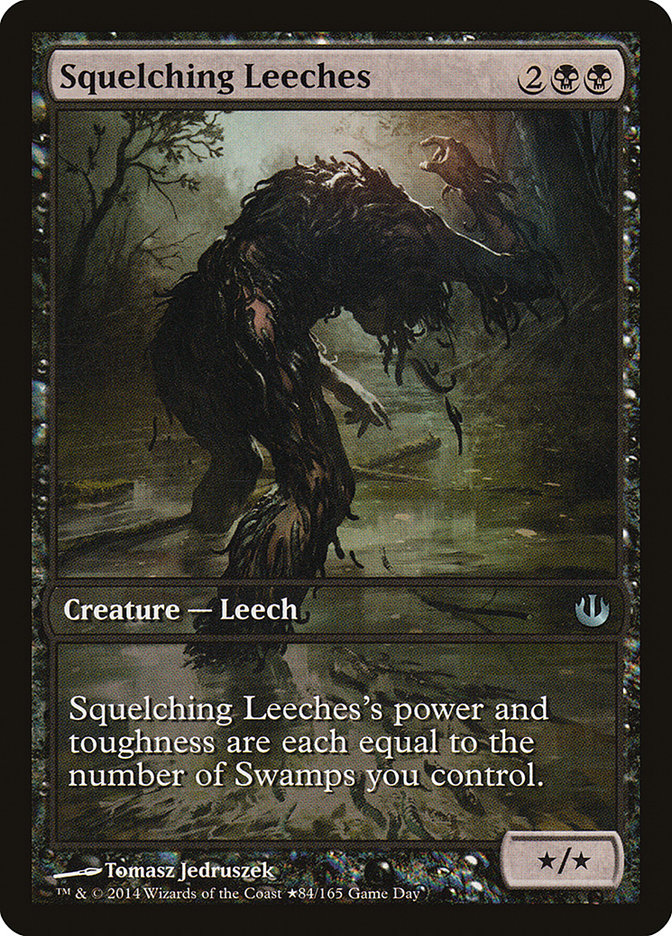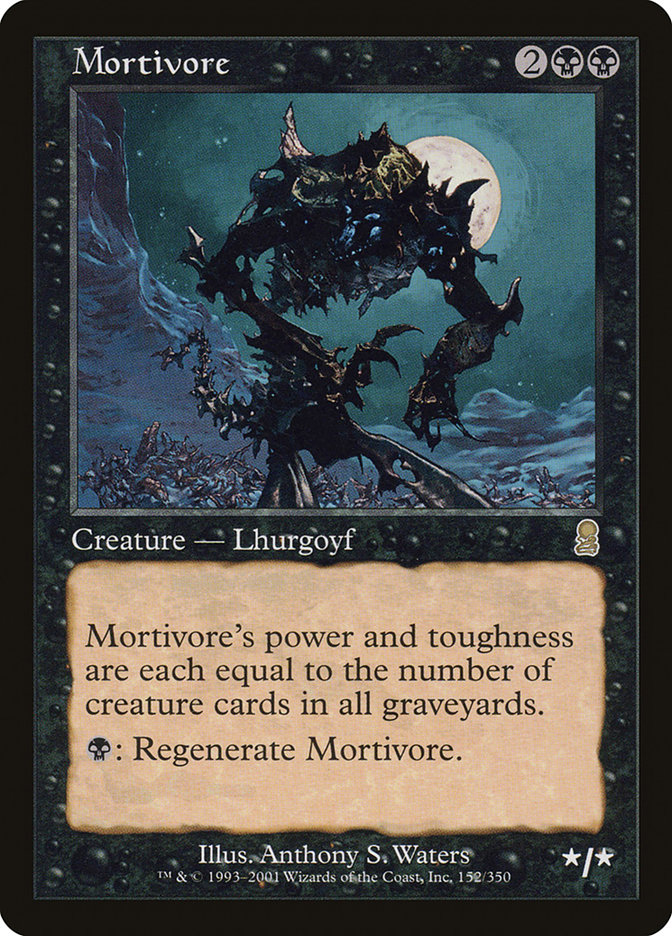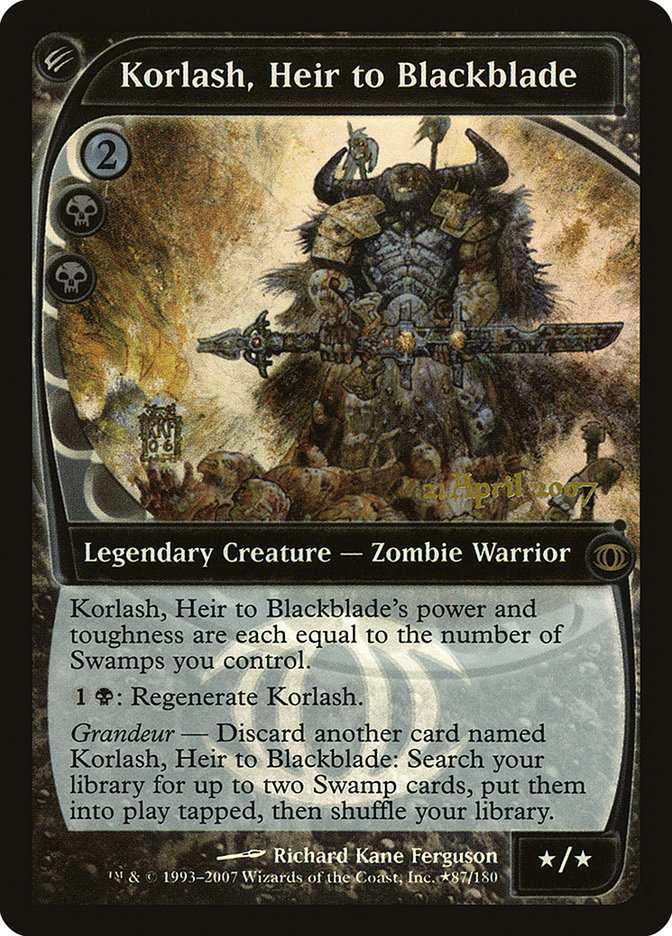Roiling Horror MTG Card
| Mana cost | |
| Converted mana cost | 5 |
| Rarity | Rare |
| Type | Creature — Horror |
| Abilities | Suspend |
| Released | 2007-02-02 |
| Set symbol | |
| Set name | Planar Chaos |
| Set code | PLC |
| Power | * |
| Toughness | * |
| Number | 79 |
| Frame | 2003 |
| Layout | Normal |
| Border | Black |
| Illustred by | John Avon |
Text of card
Roiling Horror's power and toughness are each equal to your life total minus the life total of an opponent with the most life. Suspend X—. X can't be 0. Whenever a time counter is removed from Roiling Horror while it's removed from the game, target player loses 1 life and you gain 1 life.
Cards like Roiling Horror
In Magic: The Gathering, Roiling Horror stands out as a unique creature card to inflict damage on opponents based on the number of swamp lands one controls. It’s akin to cards like Nightmare, which also scale in power and toughness with the number of swamps on the battlefield. However, Roiling Horror offers a persistent threat with its ability to return to the battlefield when an opponent’s life total changes.
Comparably, Squelching Leeches is another creature that grows with swamp dominance but lacks the resilient comeback that Roiling Horror possesses. Mortivore offers a different approach, increasing in size for each creature card in all graveyards, it doesn’t have the life total trigger effect. Then there is Korlash, Heir to Blackblade, which grows with the number of swamps you own and has the grandeur ability for added versatility, yet still doesn’t match the punishing life total dynamic of Roiling Horror.
Evaluating these similarities and differences showcases Roiling Horror’s unique position in deck strategies centered around land types and life total manipulation, a menacing addition for players favoring black mana and control tactics.
Card Pros
Card Advantage: Roiling Horror’s power lies in its potential to alter the battlefield’s dynamics significantly each time it swings in for an attack. With each life lost by your opponent, you bolster your hand, consolidating your grip on the game’s flow.
Resource Acceleration: This creature’s unique ability can disrupt the opponent’s resources while simultaneously bolstering your own. As your life total inches higher, Roiling Horror’s capacity to accelerate your advantage becomes more pronounced, giving you an upper hand as the game progresses.
Instant Speed: Roiling Horror’s ability to react at instant speed during the upkeep offers tactical flexibility. This trait ensures you can adapt to an evolving game state, putting pressure on your rivals to respond rapidly or risk falling behind as your advantage grows.
Card Cons
Discard Requirement: Roiling Horror’s ability might compel you to discard cards, strategic assets you may wish to keep in hand, in order to maximize its potential on the battlefield.
Specific Mana Cost: Roiling Horror’s casting cost demands both black and generic mana, which may not align with decks that don’t heavily feature black mana or have the capacity for flexible mana bases – potentially making it a less versatile choice.
Comparatively High Mana Cost: With a mana value that’s on the upper end of the scale, deploying Roiling Horror can be a significant investment, which may detract from your ability to play other spells or commit resources elsewhere during critical moments of the game.
Reasons to Include Roiling Horror in Your Collection
Versatility: Roiling Horror is a dynamic choice for black decks looking to utilize the power of scaling creatures. As the game progresses, it grows stronger with each player’s upkeep, making it a continually evolving threat on the board.
Combo Potential: This creature’s unique ability to accrue -1/-1 counters can be leveraged in combination with various strategies. Cards that proliferate or modify counters can be particularly synergistic, amplifying the Horror’s impactful presence.
Meta-Relevance: Given its potential for size and impact, Roiling Horror can adapt to multiple game scenarios. It thrives in environments with longer games, where its ability to disrupt opponents through life loss and its increase in size can become increasingly formidable.
How to Beat Roiling Horror
Roiling Horror is a powerful card in MTG that can disrupt your game if not checked early. Its strength lies in the fact that it grows bigger during each player’s upkeep if their life total is less—and that can spiral out of control quickly. When facing a Roiling Horror, it’s essential to prioritize life gain strategies to ensure that your life total stays on par with or higher than your opponent’s. This prevents the Horror from gaining those crucial +1/+1 counters.
Direct removal spells are a Roiling Horror’s bane. Cards such as Doom Blade, Murder, or Path to Exile can dispatch it before it becomes a massive threat. Counterspells also play a key role when Roiling Horror is cast, neutralizing the threat before it even hits the battlefield. But if combat is inevitable, chump blocking becomes necessary, so maintaining a stream of creature tokens can be a valuable tactic. Ensuring you have these aspects covered will prepare you to keep Roiling Horror in check and remain in control of the game.
To sum up, while Roiling Horror presents a formidable challenge, appropriate life management and removal strategies can ensure your dominance over this nightmarish creature, keeping you one step ahead in the game of MTG.
Where to buy
If you're looking to purchase Roiling Horror MTG card by a specific set like Planar Chaos, there are several reliable options to consider. One of the primary sources is your local game store, where you can often find booster packs, individual cards, and preconstructed decks from current and some past sets. They often offer the added benefit of a community where you can trade with other players.
For a broader inventory, particularly of older sets, online marketplaces like TCGPlayer, Card Kingdom and Card Market offer extensive selections and allow you to search for cards from specific sets. Larger e-commerce platforms like eBay and Amazon also have listings from various sellers, which can be a good place to look for sealed product and rare finds.
Additionally, Magic’s official site often has a store locator and retailer lists for finding Wizards of the Coast licensed products. Remember to check for authenticity and the condition of the cards when purchasing, especially from individual sellers on larger marketplaces.
Below is a list of some store websites where you can buy the Roiling Horror and other MTG cards:
 BUY NOW
BUY NOW BurnMana is an official partner of TCGPlayer
- eBay
- Card Kingdom
- Card Market
- Star City Games
- CoolStuffInc
- MTG Mint Card
- Hareruya
- Troll and Toad
- ABU Games
- Card Hoarder Magic Online
- MTGO Traders Magic Online
See MTG Products
Legalities
Magic the Gathering formats where Roiling Horror has restrictions
| Format | Legality |
|---|---|
| Commander | Legal |
| Legacy | Legal |
| Modern | Legal |
| Oathbreaker | Legal |
| Vintage | Legal |
| Duel | Legal |
| Predh | Legal |
| Penny | Legal |
Rules and information
The reference guide for Magic: The Gathering Roiling Horror card rulings provides official rulings, any errata issued, as well as a record of all the functional modifications that have occurred.
| Date | Text |
|---|---|
| 2007-02-01 | If your life total is less than or equal to the life total of the opponent with the most life, Roiling Horror’s toughness is 0 or less. It will be put into its owner’s graveyard as a state-based action. |
| 2007-02-01 | You never choose an opponent, and the opponent that Roiling Horror looks at is never “locked in.” Roiling Horror continuously looks at the life totals of all opponents and uses whichever value is the largest. |
| 2021-06-18 | A creature cast using suspend will enter the battlefield with haste. It will have haste until another player gains control of it. (In some rare cases, another player may gain control of the creature spell itself. If this happens, the creature won’t enter the battlefield with haste.) |
| 2021-06-18 | As the second triggered ability resolves, you must cast the card if able. You must do so even if it requires targets and the only legal targets are ones that you really don’t want to target. Timing permissions based on the card’s type are ignored. |
| 2021-06-18 | Cards exiled with suspend are exiled face up. |
| 2021-06-18 | Exiling a card with suspend isn’t casting that card. This action doesn’t use the stack and can’t be responded to. |
| 2021-06-18 | If an effect refers to a “suspended card,” that means a card that (1) has suspend, (2) is in exile, and (3) has one or more time counters on it. |
| 2021-06-18 | If the card has in its mana cost, you must choose 0 as the value of X when casting it without paying its mana cost. |
| 2021-06-18 | If the first triggered ability of suspend (the one that removes time counters) is countered, no time counter is removed. The ability will trigger again at the beginning of the card’s owner’s next upkeep. |
| 2021-06-18 | If the second triggered ability is countered, the card can’t be cast. It remains exiled with no time counters on it, and it’s no longer suspended. |
| 2021-06-18 | If the spell requires any targets, those targets are chosen when the spell is finally cast, not when it’s exiled. |
| 2021-06-18 | If this is suspended, then when the last time counter is removed from it, both its triggered ability and the “cast this spell” part of the suspend ability will trigger. They can be put on the stack in either order. |
| 2021-06-18 | If you can’t cast the card, perhaps because there are no legal targets available, it remains exiled with no time counters on it, and it’s no longer suspended. |
| 2021-06-18 | If you cast a card “without paying its mana cost,” such as with suspend, you can’t choose to cast it for any alternative costs. You can, however, pay additional costs. If the card has any mandatory additional costs, you must pay those if you want to cast the card. |
| 2021-06-18 | Suspend is a keyword that represents three abilities. The first is a static ability that allows you to exile the card from your hand with the specified number of time counters (the number before the dash) on it by paying its suspend cost (listed after the dash). The second is a triggered ability that removes a time counter from the suspended card at the beginning of each of your upkeeps. The third is a triggered ability that causes you to cast the card when the last time counter is removed. If you cast a creature spell this way, it gains haste until you lose control of that creature (or, in rare cases, you lose control of the creature spell while it’s on the stack). |
| 2021-06-18 | The mana value of a spell cast without paying its mana cost is determined by its mana cost, even though that cost wasn’t paid. |
| 2021-06-18 | When the last time counter is removed, the second triggered ability of suspend (the one that lets you cast the card) triggers. It doesn’t matter why the last time counter was removed or what effect removed it. |
| 2021-06-18 | You are never forced to activate mana abilities to pay costs, so if there is a mandatory additional mana cost (such as from Thalia, Guardian of Thraben), you can decline to activate mana abilities to pay for it and hence fail to cast the suspended card, leaving it in exile. |
| 2021-06-18 | You can exile a card in your hand using suspend any time you could cast that card. Consider its card type, any effects that modify when you could cast it (such as flash) and any other effects that stop you from casting it (such as from Meddling Mage’s ability) to determine if and when you can do this. Whether you could actually complete all steps in casting the card is irrelevant. For example, you can exile a card with suspend that has no mana cost or that requires a target even if no legal targets are available at that time. |
